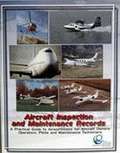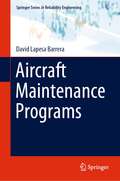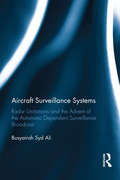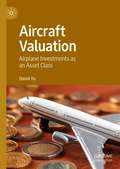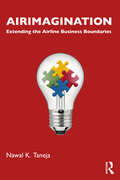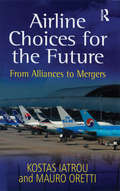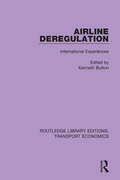- Table View
- List View
Airbus A3XX: Developing the World's Largest Commercial Jet (B)
by Michael Kane Benjamin C. EstySupplements the (A) case.
Airbus versus Boeing (A)
by Ramon Casadesus-Masanell Eric Van Den SteenLooks at the development of the competitive actions between Airbus and Boeing from 1992 to 2006. Begins with the question of whether Airbus and Boeing should collaborate on the development of a VLCT (Very Large Commercial Transport) or whether Airbus should develop their own. The case series moves through to the events thereafter of Airbus' decision to pursue the A380 and Boeing's decision relating to developing a stretch 747.
Airbus versus Boeing (A)
by Ramon Casadesus-MasanellLooks at the development of the competitive actions between Airbus and Boeing from 1992 to 2006. Begins with the question of whether Airbus and Boeing should collaborate on the development of a VLCT (Very Large Commercial Transport) or whether Airbus should develop their own. The case series moves through to the events thereafter of Airbus' decision to pursue the A380 and Boeing's decision relating to developing a stretch 747.
Airbus vs. Boeing (A)
by Ramon Casadesus-Masanell Jordan Mitchell Erich Alexander VoigtLooks at the development of the competitive actions between Airbus and Boeing from 1992 to 2006. Begins with the question of whether Airbus and Boeing should collaborate on the development of a VLCT (Very Large Commercial Transport) or whether Airbus should develop their own. The case series moves through to the events thereafter of Airbus' decision to pursue the A380 and Boeing's decision relating to developing a stretch 747.
Airbus vs. Boeing (A): Turbulent Skies
by Malcolm S. Salter Irence L. SinrichPresents the economic and political dimensions of competition in the commercial aircraft industry, as demonstrated by Airbus of Europe and Boeing of the United States.
Airbus vs. Boeing (B): Should Airbus Build the VLCT Alone?
by Ramon Casadesus-Masanell Jordan MitchellAn abstract is not available for this product.
Airbus vs. Boeing (G): New Planes and Upgrades (2011)
by Ramon Casadesus-Masanell Karen EltermanThis case describes the first commercial flight of Boeing's 787 Dreamliner in 2011, three years after originally planned, as well as the first commercial flight of Airbus's superjumbo, the A380, in 2007. It also describes the companies' current endeavors in 2011, including Airbus's work on the A350 and A320neo and Boeing's development of the 737 MAX.
Airbus vs. Boeing (G): The Dreamliner Takes to the Skies (2011)
by Ramon Casadesus-Masanell Karen EltermanThis case describes the first commercial flight of Boeing's 787 Dreamliner in 2011, three years after originally planned, as well as the first commercial flight of Airbus's superjumbo, the A380, in 2007. It also describes the companies' current endeavors in 2011, including Airbus's work on the A350 and A320neo and Boeing's development of the 737 MAX.
Airbus vs. Boeing (H): Wing Cracks and Battery Fires (2013)
by Ramon Casadesus-Masanell Karen EltermanThis case describes an issue with the batteries of Boeing's 787 Dreamliner planes overheating and sometimes catching fire in 2013. The planes were grounded for several months until Boeing introduced new safety measures. The case also discusses a problem with cracks on the wings of Airbus's A380 superjumbo, which required the company to make a costly fix to a particular wing component.
Airbus vs. Boeing (I): Airbus Introduces the A350 (2015)
by Ramon Casadesus-Masanell Karen EltermanThis case describes the introduction of Airbus's A350XWB (Xtra Wide Body) in 2015. It also describes Airbus and Boeing's current endeavors in 2015, including Airbus's development of the A330neo, Boeing's work on the 737 MAX, and Boeing's announcement of the 777X.
Airbus vs. Boeing (J): New Plane Developments (2016)
by Ramon Casadesus-Masanell Karen EltermanThis case describes Airbus and Boeing developments in 2016, including Airbus's delivery of the first A320neo and Boeing's work on the 737 MAX and 777X programs. It also notes Airbus's restructuring in 2016.
Airbus vs. Boeing (K): New Partnerships (2018)
by Ramon Casadesus-Masanell Karen EltermanThis case describes Airbus's partnership with the Montreal-based aircraft manufacturer Bombardier beginning in 2017. The two companies partnered on the C Series of aircraft (later named the A220 Family), which consisted of small aircraft with 100-150 seats. The case also describes Boeing's 2018 joint venture with the Brazilian aerospace company Embraer, which produced the E2 Family of planes (97-120 seats).
Airbus vs. Boeing (L): Discontinuing the A380 (February 2019)
by Ramon Casadesus-Masanell Karen EltermanThis case describes Airbus's February 2019 announcement that it was ending production of the A380, with the last delivery scheduled for 2021. The announcement followed an order cancellation by Emirates, a major customer of the A380. The A380 had faced significant competition from Boeing's Dreamliner, and airlines had difficulty filling their A380s enough to make them fuel efficient and cost effective. Since the plane's launch, Airbus had sold far fewer A380s than it initially predicted.
Airbus vs. Boeing (M): MAX 8 Disasters (July 2019)
by Ramon Casadesus-Masanell Karen EltermanThis case describes the October 2018 and March 2019 crashes of Boeing MAX 8 jets, which together killed over 300 passengers. The planes involved in both crashes shared a problem with a software system called MCAS, which Boeing had revamped at the last minute prior to selling the planes, but had failed to mention in its pilot manuals until after the first crash. As of July 2019, the MAX 8 remained grounded worldwide. As the investigation into the MAX 8 continued, a simultaneous investigation into a Boeing 787 factory found that the company had repeatedly ignored reports of manufacturing defects and debris left on 787s from the factory.
Aircraft Inspection And Maintenance Records: A Practical Guide To Airworthiness For Aircraft Owners, Operators, Pilots, And Maintenance Technicians
by JeppesenA practical guide to airworthiness for maintenance technicians, aircraft owners, operators, and pilots. This completely rewritten and revised fourth edition is much more than a simple introduction, this book is actually a reference, technical manual, and textbook rolled into one. Packed with photos, checklists, and concrete maintenance entries, Aircraft Inspections & Maintenance Records is an essential reference for industry professionals, students, and flying enthusiasts. Four new additional chapters incorporate many updated topics such as airworthiness determination inspection and maintenance documentation and record entries, and PIC airworthiness checks and responsibilities.
Aircraft Maintenance Programs (Springer Series in Reliability Engineering)
by David Lapesa BarreraThis book provides the first comprehensive comparison of the Aircraft Maintenance Program (AMP) requirements of the two most widely known aviation regulators: the European Aviation Safety Agency (EASA) and the Federal Aviation Administration (FAA). It offers an in-depth examination of the elements of an AMP, explaining the aircraft accident investigations and events that have originated and modelled the current rules. By introducing the Triangle of Airworthiness model (Reliability, Quality and Safety), the book enables easier understanding of the processes by which an aircraft and its components are deemed to be in a safe condition for operation from a cost-effective and optimization perspective. The book compares the best practices used by top airlines and compiles a series of tools and techniques to improve the standards of the AMP. Aircraft maintenance engineers, students in the field of aerospace engineering, and airlines staff, as well as researchers more widely interested in safety, quality, and reliability will benefit from reading this book
Aircraft Surveillance Systems: Radar Limitations and the Advent of the Automatic Dependent Surveillance Broadcast
by Busyairah Syd AliThe Communication, Navigation and Surveillance (CNS) systems provide air traffic controllers with the information necessary to ensure the specified separation between aircraft and efficient management of airspace, as well as assistance to flight crew for safe navigation. However, the radar systems that support air traffic management (ATM), and in particular air traffic control (ATC), are at their operational limit. This is particularly acute in the provision of the ATC services in low altitude, remote and oceanic areas. Limitations in the current surveillance systems include unavailability of services in oceanic and remote areas, limited services during extreme weather conditions, and outdated equipment with limited availability of spare parts to support system operation. These limitations have resulted in fatal accidents. This book addresses the limitations of radar to support ATC in various operational environments, identified and verified by analysing five years of safety data from Avinor, the Air Navigation Service Provider (ANSP) in Norway. It derives a set of taxonomy and from this develops a causal model for incident/accident due to limitations in the surveillance system. The taxonomy provides a new method for ANSPs to categorize incidents while the causal model is useful for incident/accident investigations. The book also provides theoretical justifications for the use of Automatic Dependent Surveillance Broadcast (ADS-B) to overcome the limitations of radar systems and identify areas of improvements to enable seamless ATC services. Written in a style that makes it accessible to non-specialists, Aircraft Surveillance Systems will be of interest to many in the field of aviation, particularly ATM, safety and accident/incident investigation. It will also offer a useful reference on this vital topic for air traffic management courses.
Aircraft Valuation in Volatile Market Conditions: Guiding Toward Profitability and Prosperity (Management for Professionals)
by Bijan Vasigh Farshid AzadianThis book provides indispensable knowledge for practitioners in aircraft financing. It presents an innovative framework that treats valuation analysis as a systematic effort in problem-solving directed at rational financial decision-making. It incorporates much of the modern approach to financial investment decision-making. It proposes essential tools of flexibility, adaptability, and commonality of aircraft financial analyses that apply to an almost infinite variety of valuation problem situations. Once these connections have been introduced, the reader will be equipped with an understanding of the underlying concepts of aircraft valuation processes and techniques and the subsequent financing alternatives available to fund aircraft assets. This is an essential book for airline professionals, aircraft leasing companies, consultants, bankers, government officials, and students of aircraft finance. It is an approachable resource for those without a formal background in finance.
Aircraft Valuation: Airplane Investments as an Asset Class
by David YuThis book is one of the first to explore aviation and aircraft leasing and its values establishing it as a standalone investable asset class within the larger real assets industry. Airplanes are a crucial but capital-intensive component of the global economy. The author, as an academic, researcher, appraiser, advisor and businessperson in the industry, bridges a gap in the existing literature with his analysis of the underlying aviation asset class return and risk profile. The book describes the characteristics, dynamics and drivers of the global, Asia and China specific aviation and leasing landscapes. Recent effects of COVID-19 on aviation and an analysis of the drivers affecting cross border mergers and acquisitions in the industry are also investigated. The book includes 20+ years of empirical aircraft valuation evidence and analysis of its characteristics establishing the aircraft and sub-segments as asset classes. In addition, characteristic comparisons to other real asset subclasses and benchmarks are examined. This book will be of interest to academics, financiers, investors, industry participants and more general aviation enthusiasts.
Airgas, Inc.
by Eric J. Van Den Steen Jason KarlIn 2013, Airgas was the market leader in packaged industrial gas distribution. Recent acquisitions had made it into a larger player in upstream gas production as well, where it competed with Praxair and Air Products. Should Airgas continue building a position in gas production or divest these activities?
Airimagination: Extending the Airline Business Boundaries
by Nawal K. TanejaUnprecedented social changes, accelerated by facilitating technologies and the COVID-19 pandemic, are calling for airlines to think deeply and non-conventionally on what will be important to existing and new travelers, as they change their lifestyles. New thinking requires airlines to extend the boundaries of their businesses to go beyond their traditional domains. This need goes beyond the renovation and iteration of conventional products to the transformation of products requiring new ideas and ways to scale them. Examples include the development of cost-effective urban air mobility, intermodal passenger transportation, door-to-door travel that is sustainable, and personalized offers. Airimagination: Extending the Airline Business Boundaries raises some thought-provoking questions and provides a direction for practical solutions. For example, what if airlines developed products and services that finally meet end-to-end needs of customers seamlessly by collaborating in the value-adding open ecosystems, using platforms that facilitate effective engagement with both "digital and nondigital" customers and employees in real time and at each touch point? Ironically, the current time is an advantage for some airlines as they already have had to deal with a deep and wide disruption caused by the pandemic, leading operations to start from ground zero. This book, the latest in a long and well-regarded series by Nawal K. Taneja, explores innovative best practices within the airline business world, complemented by numerous insightful perspectives contained in multiple forewords and thought leadership pieces. This book is aimed primarily at high-level practitioners within the airline industry and related businesses.
Airline Business in the 21st Century
by Rigas DoganisThis book focuses on the major issues that will affect the airline industry in this new millennium. It tells of an industry working on low margins and of cut-throat competition resulting from 'open skies'. Among the issues discussed are:* the low-cost airline* the impact of electronic commerce* the debate on global airline alliances* privatizing state-owned airlines* the creation of a Trans Atlantic Common Aviation areaMost importantly, the book carefully analyzes the strategies that are needed for airlines to succeed in the twenty-first century. This is essential reading for anyone interested in aviation.
Airline Choices for the Future: From Alliances to Mergers
by Kostas Iatrou Mauro OrettiAirline Choices for the Future: From Alliances to Mergers offers an up-to-date assessment of the industry as it stands today, delivering a comprehensive insight into how the world of airline alliances is changing, and how the merger phenomenon is likely to fit into the new scenario. The purpose of this book is twofold. Firstly, it outlines the evolution and the reasons behind alliances between international air carriers, the alliances' track records and the way they have affected airlines and the air transport industry. Secondly, drawing on past and more recent developments in the industry, it examines the experiences airlines involved in cross-border mergers have gone through and the advantages and difficulties they have come across. Alliances and mergers are presented from both the airline and the consumer perspective. The book provides a balanced account of where mergers and alliances have taken the industry to date, bridging the gap between merger theory and implemented practices and strategies. It also identifies the challenges alliances and cross-border mergers have faced and highlights the key forces affecting airline development. Theoretical evidence is supplemented by data collected via surveys and interviews with airline executives, aviation experts, consultants and regulatory bodies.
Airline Deregulation: International Experiences (Routledge Library Editions: Transport Economics #1)
by Kenneth ButtonThe end of the twentieth century saw remarkable changes in the way that economic regulation was viewed. There occurred a liberalization of attitude and something of a withdrawal of the state from its interventionist role. These changes were particularly pronounced in the context of transport, where the long-standing tradition had been one of market intervention by the government. The aim of this book, first published in 1991, is to examine the outcomes of deregulation on the international airline industry, and to consider whether the experiences of market liberalization reveal any common threads. In particular, whether they reveal any universal indications of how underlying transport markets function; how management responds to new stimuli; the degree of protection needed by transport users; and nature of the transition process from regulation to liberalization.
Airline Economics: An Empirical Analysis of Market Structure and Competition in the US Airline Industry
by Giovanni Alberto TabaccoThis book presents an original empirical investigation of the market structure of airline city pair markets, shedding new light on the workings of competitive processes between firms. Examining a cross-section of US airline city pairs, Tabacco proposes for the first time that the industry can be understood as a natural oligopoly, each airline market being dominated by one to three airline carriers regardless of market size. The author questions the extent to which airlines deliberately prevent head-to-head competition within city pair markets, and draws intriguing conclusions about competitive forces from the observed market structure. Uncovering some of the main corporate strategies of the airline industry, the book is of immediate relevance to industry managers and practitioners, as well as academic economists.

